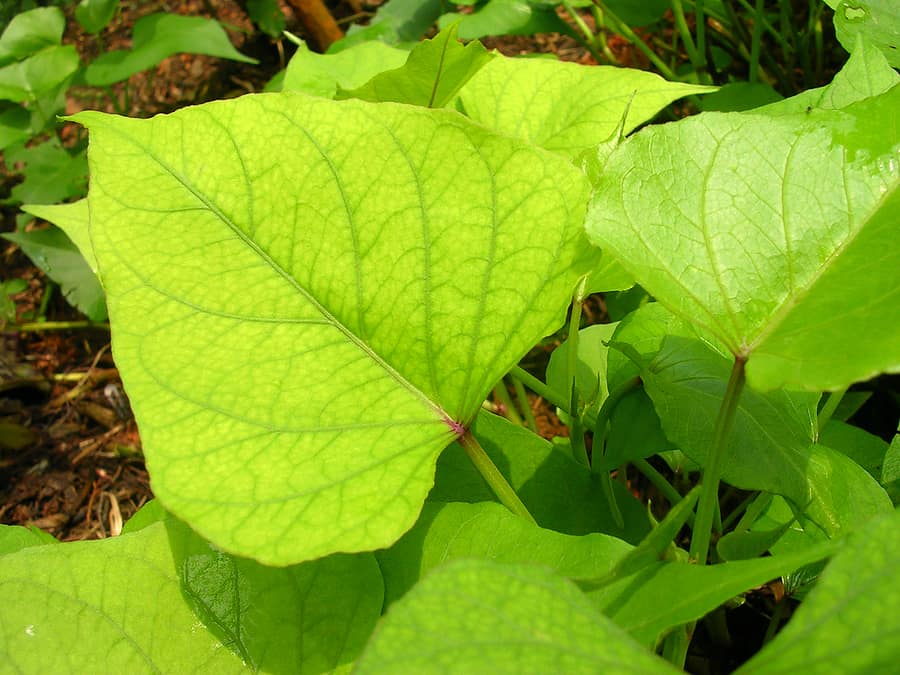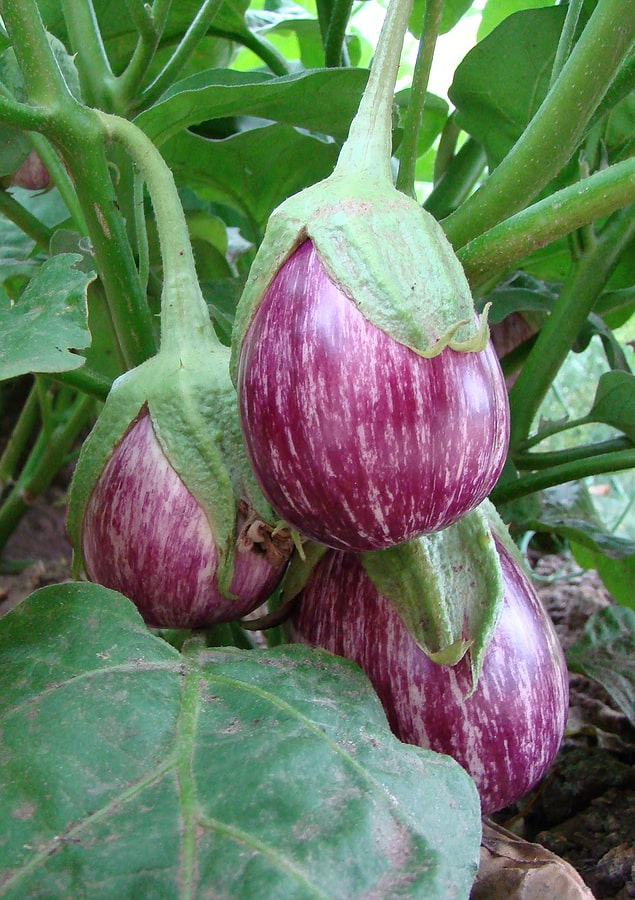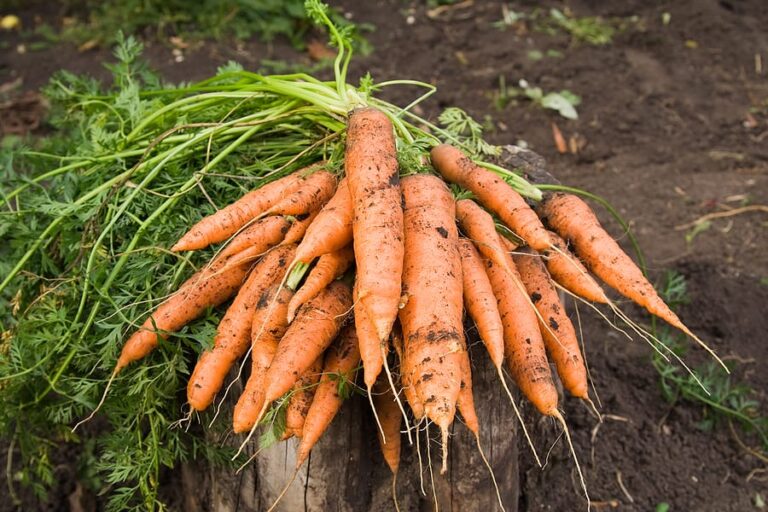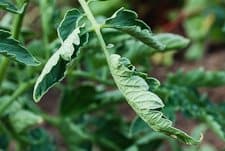Sweet Potato Growing Problems: Troubleshooting
Sweet potatoes require loose, well-drained soil and about 100 very warm days.
Sweet potatoes are usually grown from slips started from roots (to start your own add another 40 days).
Set sweet potato starts into the garden about the same time you set out tomato transplants in spring.
For sweet potato growing tips see Sweet Potato Growing Success Tips at the bottom of this post.
Here are common sweet potato growing problems with cures and controls.
Seedling problems
Transplanted slips or sprouts die or do not produce vines
Sweet potato transplants (slips) must be kept evenly moist until they root. Transplant out slips that are good-sized, not slips that are thin or frail. Set transplants in the ground up to their top leaves; bury the remaining nodes so that they will root.
Leaf problems
Leaves become yellow or brownish, wilt and droop, brown to black steaks inside stems; plant becomes stunted
Fusarium wilt is a fungal disease that infects plant vascular tissues. Fungal spores live in the soil and can be carried by cucumber beetles. Plant disease-resistant varieties. Rotate crops. Remove and destroy infected plants. Fungicides are not effective.
Water-soaked blotches on leaves–not enlarging past leaf veins
Leaf spot or bacterial spot is a waterborne bacterium that causes irregular geometric patterns on leaves. Spots may turn yellow and crisp. Avoid wetting foliage with irrigation. Prune off infected leaves and stems. Clean up garden. Plant disease-resistant varieties. Rotate crops for up to 2 years.
Small shot holes in the leaves of seedlings
Flea beetles are tiny bronze or black beetles a sixteenth of an inch long. They eat small holes in the leaves of seedlings and small transplants. The larvae feed on the roots of germinating plants. Spread diatomaceous earth around the seedlings. Cultivate often to disrupt the life cycle. Keep the garden clean.
Leaf and root problems
Holes in leaves and roots
Larvae of sweet potato weevil is a white, legless grub with a pale brown head about 3/8 inches long; the adult beetle has a reddish snout. The grub will tunnel through leaves and roots. Pick off weevils. Remove and destroy infested plants. Sprinkle plants with diatomaceous earth. Cultivate the planting bed before planting to disturb the weevil’s life cycle.
Leaves turn yellow and then brown from the bottom up; plant loses vigor; cracks in roots
Root-knot nematode is a microscopic eelworm that attacks roots. Plant disease-resistant varieties. Rotate crops. Remove old plant debris from the garden. Root cracks also can be the result of too sudden uptake of water; keep watering even; avoid dry and wet spells.
Root-tuber problems
Roots are elongated, slender
Too frequent watering. Sweet potatoes require consistent, even moisture, but roots should not be constantly moist. Water deeply for 2 to 3 hours at a time then allow the soil to dry to a depth of 6 to 8 inches before watering again. Heavy, clay soil that retains moisture can cause sweet potato roots to become long and stringy. Add aged compost to planting beds to increase drainage.
Root flesh is stringy
The soil is too wet. Roots should not be kept constantly moist. Avoid overwatering; make sure the soil is well drained. Water deeply for 2 to 3 hours at a time then allow the soil to dry to a depth of 6 to 8 inches before watering again. Heavy, clay soil that retains moisture can cause sweet potato roots to become long and stringy. Add aged compost to planting beds to increase drainage. Reduce watering a few weeks before harvest.
Tunnels or hole in the tubers
(1) Wireworms or (2) sweet potato weevil: (1) Wireworms are the soil-dwelling larvae of click beetles; they look like wiry-jointed worms. Check the soil before planting; flood the soil if wireworms are present. Remove infested plants and surrounding soil. (2) Sweet potato weevil is a blue-black weevil that resembles a black ant; the larva is a white, worm-like grub that will feed on plant stems and roots. Weevils lay eggs in the soil and the worm-like larvae will eat stems and roots. Mound up soil around plants so that weevils can not reach roots. Dust plants with a small amount of diatomaceous earth.
Round to black spots and blotches on the root surface
Black scurf is a fungal disease that favors warm soil. Remove infected plants and plant debris that harbor fungal spores. Rotate crops. Be sure slips are not diseased. Plant certified disease-free slips. Rotate crops regularly. Solarize the soil in late spring or summer. Black scurf is resting spores; peel away the surface spores before using the root.
Black sunken spots on roots and underground stems; leaves are yellow
Black rot is a fungal disease. Roots will have circular black decayed areas that become dry and corky. Use only certified healthy slip and resistant varieties. Keep the garden free of weeds; some diseases are spread by insects such as the sweet potato weevil. Avoid bruising tubers at harvest.
Internal cork, hard corky spots in root
Internal cork is a viral disease transmitted in the propagation, using diseased stock and also by aphids. Leaves will become mottled and yellowish along veins. Plant certified virus-free slips. Control aphids. Do not save roots from infected crops for planting next year.
Sweet potatoes have poor flavor
Harvest roots before soil temperatures drop below 55°F. Harvest should be completed before the first frost.
Roots rot after harvest
Bacterial rots can enter roots through harvest wounds; sweet potatoes are very thin-skinned. Cure just harvested roots for about a week at 75°F. Store cured sweet potatoes wrapped in newspapers at about 55°F.
Parts of the roots are hard after cooking
Sweet potatoes should be stored at about 55°F, not cooler. The tissue of roots stored too cold will become dry and hard.
Sweet potato growing success tips
Planting
Grow sweet potatoes in full sun. Work 2 to 4 inches of aged compost into the planting beds before planting. Plant rooted slips for best results. You can start your own slips from sweet potatoes grown the year before. Allow 40 days for sweet potatoes to root. Use a large, firm sweet potato; place the potato in a pot of moist sand leaving two-thirds of the root exposed. Put the root in a sunny place at about 75°F. When sprouts are 4 to 6 inches long, twist them from the potato and put them in water or wet sand to root. Transplant the slips into the garden when the roots are about 2 inches long.
Planting time
Plant sweet potato slips after the soil has warmed in spring to at least 65°F or warmer; a soil temperature of 80°F is ideal. In cool regions, grow dwarf or early-maturing varieties and plant them in raised mounds or raised beds where the soil warms quickest and stays warm.
Care
Sweet potatoes prefer regular, even watering until they are established. Keep planting beds weed-free.
Harvest
Begin lifting sweet potatoes when they have reached the number of days required for maturity–check the seed packet or a growing guide. Keeping track of average days to harvest is the best way to know when to harvest sweet potatoes. An unharvested sweet potato will continue to grow and grow, but it is best harvested young. Sweet potato tubers are easily injured so lift them gently after loosening the soil with a spading fork. Cure sweet potatoes for 10 days in a dry, shady place before using.
Sweet Potato Learning Hub
Start Here
Planning & Preparation
- The Best Growing Conditions for Sweet Potatoes: Soil, Sun, and Temperature Needs
- When to Plant Sweet Potatoes: Timing for Warm Climates and Short Seasons
- Top Sweet Potato Varieties for All Regions
Starting Slips & Planting
- How to Start Sweet Potato Slips at Home: Step-by-Step Guide for Beginners
- How to Plant Sweet Potatoes: Soil Prep, Spacing, and Transplanting Slips
- Growing Sweet Potatoes in Raised Beds: Soil Depth, Amendments, and Spacing
- How to Grow Sweet Potatoes in Containers: Pot Size, Soil Mix, and Vine Training
Early and Mid-Season Growth
- Quick Growing Tips for Sweet Potatoes: Fast Success From Slips to Harvest
- How to Water Sweet Potatoes for Healthy Vines and Large Tubers
- How to Fertilize Sweet Potatoes: Organic Feeding for Bigger Harvests
- Sweet Potato Care Throughout the Season: Training, Mulching, and Vine Management
- The Best Companion Plants for Sweet Potatoes (and What to Avoid)
Problems & Troubleshooting
- Common Sweet Potato Pests and Diseases: How to Stop Them Organically
- Why Sweet Potatoes Don’t Form Tubers (and How to Fix It)
Harvest, Curing, & Storage
Using Your Harvest
Related articles:
How to Plant and Grow Sweet Potatoes
Sweet Potato Plant Starting Tips
How to Harvest and Store Sweet Potatoes
Seven Ways to Cook and Serve Sweet Potatoes
Sweet Potato Growing Problems: Troubleshooting
Vegetable Garden Diseases Problem Solver
Vegetable Garden Organic Weed Control
Garden Planning Books at Amazon:




